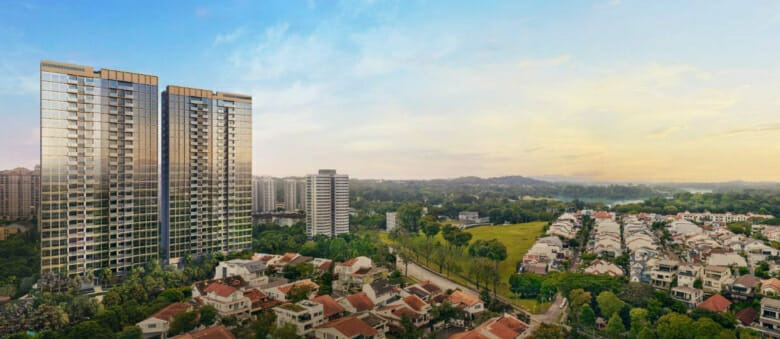
Projects like AMO Residences drove suburban home price growth last quarter. (Source: UOL Group)
Singapore’s housing market continues to heat up despite a challenging macroeconomic landscape, with a spike in demand for suburban housing helping to drive up private home prices at a faster than estimated 3.8 percent in the third quarter.
A final report released by the Urban Redevelopment Authority (URA) on Friday showed that an index tracking sales of non-subsidised housing in Southeast Asia’s most expensive city rose to 187.8 in the three months ending 30 September from 180.9 in the April through June period. The market tracker showed a steeper rate of change than the 3.4 percent growth indicated in flash estimates issued by the URA earlier this month.
Last quarter’s pace quickened from the 3.5 percent jump in prices for luxury condos, landed homes and other private housing witnessed over the previous three month period, as prices for suburban dwellings rose at their fastest pace since the waning days of the global financial crisis in late 2009. Despite the third quarter leap, however, analysts expect the market to slow down for the remainder of 2022.
“Q3 2022 figures have continued to demonstrate the strong purchasing power of home buyers, with higher mortgage rates appearing to have a limited impact on sentiments,” said Catherine He, director and research head for Singapore at Colliers. “With the year end holiday season and higher mortgage rates, both buyers and developers are likely to sit out the rest of the year to see how the market plays out post the 29 September cooling measures.”
Suburban Prices Catching Up
The latest figures marked the 10th straight quarter of growth for private home prices in Singapore, with the price index jumping 13.6 percent from September 2021 through the end of last month.

Catherine He, head of research at Colliers
By region, condo prices in the suburbs, or what the URA refers to as the outside central region (OCR), rose most quickly at 7.5 percent last quarter – faster than its 2.1 percent uptick in the preceding three months.
Rising housing costs in the region were mainly attributed to robust sales from three projects launched during the period, led by a joint venture of UOL, Singapore Land and Kheng Leong selling out 98 percent of the units in its AMO Residence project in Ang Mo Kio in its July launch.
Adding to the suburban strength were the launches of Frasers Property’s Sky Eden@Bedok in Bedok Central and GuocoLand’s Lentor Modern in the Thomson area last month, which have already found buyers for least three-quarters of their homes.
Prices in city-fringe locations, referred to as the rest of central region (RCR) rose at a softer 2.3 percent increase last quarter, slowing markedly from the 6.4 percent pace in the second quarter. For the prime residential locations in the city centre, known as the CCR, price growth inched up by 2.3 percent in the July to September period versus the 1.9 percent increase seen from April through June.
With suburban prices picking up, PropNex chief executive Ismail Gafoor noted that the price gap between the suburbs and RCR narrowed to 19 percent last quarter from 28 percent in the preceding three months. When compared to the core central region, the gap was trimmed to 38 percent from 55 percent.
“The private residential market has demonstrated remarkable resilience, weathering the Covid-19 pandemic, growing uncertainties, and the cooling measures in December 2021,” Gafoor said. “Recently, the government introduced more cooling measures amid rising interest rates to prevent home buyers from overstretching themselves – measures which are needful and timely, in our view.”
Price Growth Picked to Slow
The government reacted to Singapore’s persistent home price increases with fresh property cooling measures on 29 September, after a set of market curbs established in December last year failed to dent buyer demand.
URA statistics showed private home prices rose by 8.2 percent in the nine months ending September, outpacing the 5.3 percent growth in the same period last year. Since the pandemic triggered a fresh round of quantitative easing globally two years ago, the Lion City has seen its home prices leap by 23.5 percent from the first quarter of 2020 through the end of September.
OrangeTee & Tie predicts 2022 price increases could reach up to 11 percent – surpassing last year’s 10.6 percent expansion.
Cushman & Wakefield and a number of other analysts are predicting price growth of between 8 to 10 percent, with some seeing that pace slackening to 3 to 4 percent next year on rising market uncertainties.
“We do not expect developers to reduce prices at new launches given their healthy balance sheet,” Cushman & Wakefield’s research head for Singapore, Wong Xian Yang, said. “Developers are likely to pace out their launch progress and recalibrate their marketing strategies in view of a potentially lower demand due to higher interest rates and an economic slowdown.”
Double Digit Rental Growth
In the leasing market, private residential rents continued to test the budgets of tenants, rising by 8.6 percent last quarter from the previous three months and accelerating from the 6.7 percent growth logged in the second quarter.
For the first nine months of this year, home rental rates grew by 22 percent yearly compared to the same period in 2021, as vacancy dipped to 5.7 percent.
“Tight supply situation would underpin occupancy rate and rental growth,” C&W’s Wong said. “However, tenants’ resistance might kick in as rent growth has been accelerating for the past few quarters,” he added, while predicting that rents will rise at a slower pace in 2023.
Leave a Reply